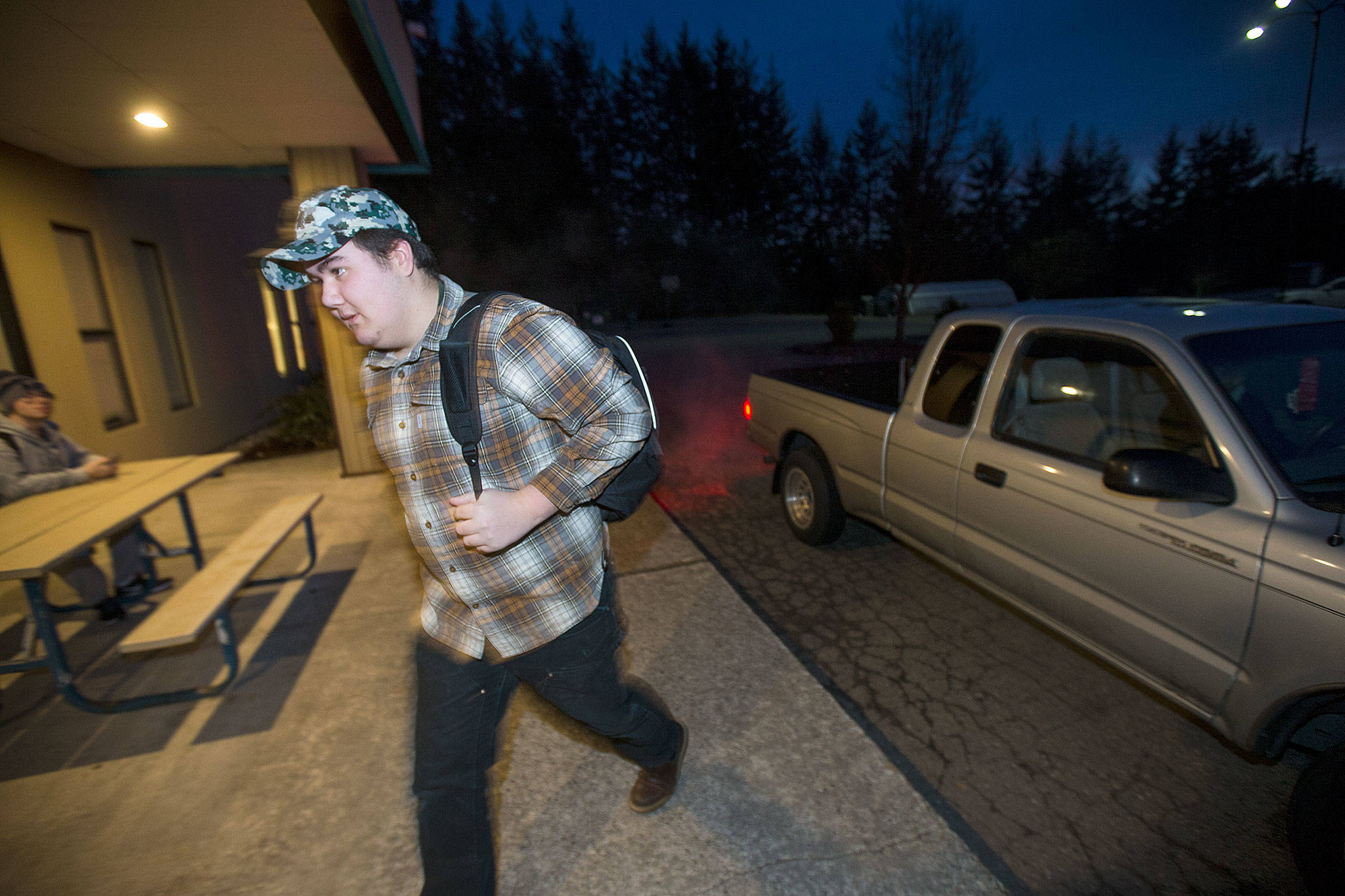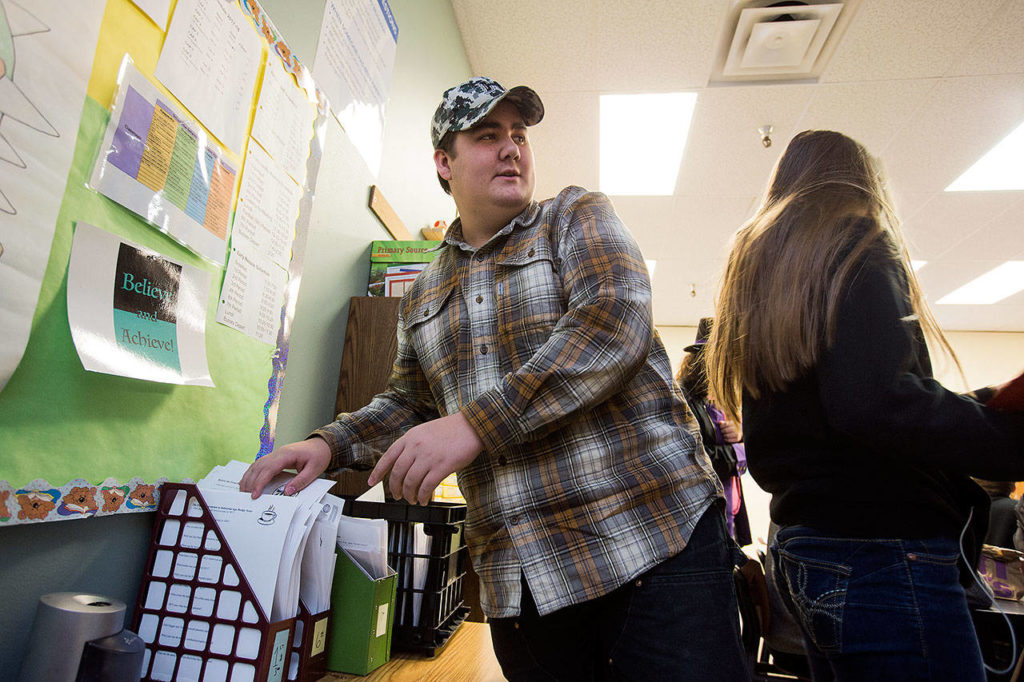ARLINGTON — The morning routine was a charade.
Sean Costello would drop his son off near the front doors to Arlington High School.
Keinen LaRose might stay awhile, but he’d often head home when the coast was clear.
He’s one of about 6 million students nationwide who miss enough school to be labelled chronically absent. In Snohomish County, 14.5 percent meet that definition, meaning they miss at least 10 percent of school, excused or unexcused. Keinen was absent more frequently than most, gone 110 days over two years.
Sean and Cheyenna Costello so wanted their son to go to school. They dreaded voice-mail messages about Keinen’s missed classes or looking online at an electronic grade-book that showed failing grades and mounting absences.
They have always understood that school was not easy for their son. Keinen, years ago, was diagnosed with ADHD, Attention Deficit Hyperactivity Disorder, but that didn’t mean he couldn’t learn. He’s smart enough. It was his inability to confront problems before they’d snowball that got him in trouble.
It seemed as though the harder they tried, the greater the conflict grew at home.
His parents tried many strategies. Sean began taking the Xbox gaming equipment with him when he left for work and remotely turned off the Wi-Fi if he discovered it was on when Keinen was supposed to be in school.
It seemed Keinen was perpetually grounded.
Meetings with teachers didn’t go especially well; Keinen was often too far behind to catch up. Cheyenna wondered if she should quit her job to make sure her son went to his classes.
The family was summoned to court for truancy hearings at the Denney Juvenile Justice Center in Everett. They had a short-term effect before old habits returned.
“It was upsetting and frustrating and after a while you just got numb,” Sean Costello said.
“We were at our wit’s end,” his wife said.
After two years of high school, Keinen had earned just one-half credit.
Last spring, at the height of their exasperation, a letter arrived.
The Arlington School District recently had formed a truancy board, which requested they appear at a hearing.
It seemed worth a try.
Taking on truancy
Arlington didn’t decide out of the blue to create a community truancy board. The Legislature figured the boards would be a good idea statewide to divert students away from the courtroom and juvenile lockup.
Beginning this year, school districts are required to have community truancy boards. With help from local juvenile justice system workers, several are up and running.
The community boards offer a new layer of intervention. Court remains an option of last resort.
Washington has been among the states most likely to lock up students for chronically missing school. In 2016, 5.9 percent of juveniles in detention were there for being truant.
Washington’s hard line toward truancy began with the Becca bill. The 1995 law is named for Rebecca Hedman, a 13-year-old runaway murdered in Spokane County. It is meant to help parents protect their children. It requires school districts to report absences to parents, as well as to file truancy petitions with the courts if a child has seven unexcused absences in a month or 10 in a year.
In some parts of the country, spotty attendance has been found to be a better predictor of whether students will drop out than test scores.
Nationally, nearly one in five high school students is considered chronically absent, according to 2014 statistics. The rates are 12 percent of middle school students and 11 percent in elementary school. The Snohomish County average for all grades was 14.5 percent compared to 16.7 percent statewide in 2016.
The statistics are concerning at all grade levels. Children chronically absent in kindergarten and first grade are much less likely to read at grade level by the third grade. In turn, students who aren’t able to read at grade level by the end of third grade are four times more likely to drop out of high school than their peers.
Many approaches have been tried across the country to improve attendance. Sometimes, it is as simple as explaining to parents why it is important. A “No Pass, No Drive” law in some states appears to have helped reduce absenteeism among high school students.
Bob McClure, who spent more than 20 years on the Arlington School Board before stepping aside earlier this month, has high hopes for community truancy boards. He likes the idea of more local intervention instead of referring students to the courts.
“Finding out what that issue is, finding out how we can resolve that individual’s issues, that’s one of the beauties of local boards, the local control,” he said. “Those are the kinds of things that need to be handled on a local basis.”
In the Everett School District last month, nearly 90 people were trained to serve on truancy boards. They included school administrators, counselors, family advocates and folks from the community. The plan is to have boards for all 26 schools in the district, even though some will seldom have reason to meet.
Last spring, the district began piloting truancy boards at two high schools and a middle school. Roughly 25 students and their families attended the sessions; many more were invited but didn’t show up.
“Each student and family is unique,” said Jeanne Willard, the district’s director of on-time graduation. “Many students do start attending school again and become more engaged.”
Even some of those who didn’t go to the meetings got the message and began showing up to class.
In Mukilteo, a truancy board has worked on 10 cases this fall.
“Some of those students have followed the developed plan and are back in school on a more regular basis with the students, parents and school all on the same page,” said Andy Muntz, a district spokesman. “Some only maintained a good try for about a week and we have had to go the next step to taking them to court.”
The district hired someone in February to focus on improving attendance, a challenge that increases the older students get.
“By the time a student reaches high school, it’s hard to change their behavior and engage them, especially if he or she is struggling socially, emotionally and academically,” Muntz said.
Following up is key
For several years, social worker Joanna Dobbs spent her days with homeless teens through Cocoon House in Everett. She saw how complex their lives could be.
These days, Dobbs is with the Stanwood Camano Community Resource Center and still works with teens. She’s also a volunteer member on the Stanwood-Camano School District’s community truancy board.
By design, it is the student who does most of the talking at the hearings, she said.
Dobbs knows it can take time to get to the root of their problems. She also believes that community boards can help not just during the hearings, but in the weeks and months afterward by personally checking in with the students. That’s what she did with a Lincoln Hill High School student last spring. Today, he’s doing well.
“The best results come from follow-through and mentoring from our (truancy) board members,” said Lloy Schaaf, an assistant superintendent in the Stanwood-Camano district.
Caireanna Mills, 17, is a poster child for how timely adult intervention can make a monumental difference. By age 12, she’d learned about evictions, couch surfing and the perils of parental drug abuse. Her frequent absences at Eisenhower Middle School led to Becca bill reports and arrangements for her to get rides to school in patrol cars.
School counselor Jaimie Burton and Everett Police Youth Services Sgt. Tim Reeves were keeping a watchful eye over her.
Burton continued to stay involved. She is now a counselor at Everett’s Sequoia High School where Mills is a senior. She knows there are many Caireannas out there whose lives are complicated and whose absences are not always a choice. It is why the counselor often tells students: “I need to see your face. I need to see your eyes. I need to be able to know how you are doing.”
Earlier this month, a judge signed an order granting Mills emancipation from her parents.
In many ways, school staff and friends have been the teen’s family.
“I’m so grateful for everything, you know? It’s still mind-blowing,” Mills said.
“Someone was watching over me,” she said, as if quoting a familiar line, but looking at Burton with a smile.
Mills dreams of college and a career in law enforcement.
Out of the sand
Keinen LaRose was nervous the evening of his hearing before Arlington’s truancy board.
The 16-year-old expected more interrogation than conversation.
The board, he soon realized, wasn’t talking at him but to him. The group wanted to pry into the why, what was making him not want to go to school.
Keinen opened up. He’d become overwhelmed.
“He would be so far behind and he would just stick his head in the sand,” his father said. “Instead of grabbing a shovel he would let it fall in on him. It really helped him pull his head out of the sand.”
On the panel was Terri Bookey, his elementary school principal and now the district’s director of early learning. Bookey remembered Keinen well. She wanted him to understand that the purpose of the truancy board is not to be punitive but to remove barriers and to follow up.
“They still need guidance and support all the way through high school,” she said.
“It’s really an olive branch out to the student and family, and then some problem solving,” said Kathleen Ehman, an Arlington assistant superintendent.
These days, Keinen attends Weston High School near the Arlington Municipal Airport. It is smaller, more hands-on and less chaotic for him. Keinen’s goal is graduate and become a heavy machinery operator.
Sean Costello still drives his son to school. They hop into their Toyota pickup truck before 7 a.m., roll down the hill to the flats and exchange “Have a good days” in the parking lot.
Keinen is among the first to arrive, a good 45 minutes before first period. He likes the quiet time, the chance to organize his thoughts and take inventory of his backpack.
With shorter academic terms, he’s chipping away at credits.
Etched in his memory is the sadness on his parents’ faces at one of his court hearings.
“I think like all kids the one thing that hurts the most is when they say they are not mad, they are just disappointed, and that’s kind of what I was feeling,” he said.
Keinen hopes to make up for lost time. His trek is fraught with temptation. Not long ago, Keinen earned an award for perfect attendance, but was absent the day he was supposed to receive it.
That has been the aberration, not the rule.
His parents say their son seems less impulsive, more mature and much happier.
For the first time in a long time, he doesn’t dread school.
“I have to work on some other classes still, but it’s getting there,” he said. “I’m moving forward.”
Melissa Slager contributed to this story.
Eric Stevick: 425-339-3446; stevick@heraldnet.com.
Talk to us
> Give us your news tips.
> Send us a letter to the editor.
> More Herald contact information.


























